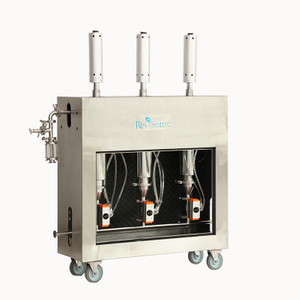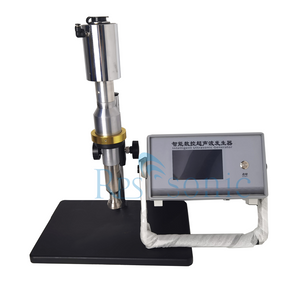Particle dispersion refers to the process where powder particles separate and disperse uniformly throughout a liquid medium. Depending on the dispersion method, it can be categorized as follows:
Mechanical stirring dispersion: Primarily utilizing mechanical energy such as shear or impact forces to disperse nanoparticles in the medium. By applying mechanical force to the dispersion system, physical and chemical changes in the system's substances occur along with a series of chemical reactions to achieve dispersion. However, the presence of grinding media during the grinding process introduces new impurities and imposes certain limitations on the formation of submicron particles.
A mechanical stirrer is a device that forces convection and uniform mixing of liquid or gas medium. The type, size, and speed of the stirrer affect the distribution of stirring power between overall flow and eddy current pulsation. Typically, the power distribution of a turbine-style stirrer is advantageous for eddy current pulsation, while a propeller-style stirrer is beneficial for overall flow. For a given type of stirrer, under the condition of equal power consumption, a large-diameter, low-speed stirrer mainly consumes power in the overall flow, favoring macroscopic mixing. A small-diameter, high-speed stirrer mainly consumes power in eddy current pulsation, favoring microscopic mixing.


Ultrasonic dispersion: A common material dispersion technique that utilizes high-frequency ultrasonic waves to disperse materials into small particles, achieving uniform mixing.
Ultrasonic dispersion is a process that utilizes the mechanical vibration of ultrasonic waves to disperse particles in a liquid. In this process, the ultrasonic wave source generates high-frequency vibrations that propagate through the liquid, creating strong mechanical shear forces and microflows, effectively dispersing particles evenly in the liquid.
One reason for the presence of ultrasonic dispersion equipment is the occurrence of tensile stress in the liquid, leading to the formation of negative pressure locally. The decrease in pressure causes gases originally dissolved in the liquid to become oversaturated and escape from the liquid, forming small bubbles. Another reason is the powerful tensile stress that "tears apart" the liquid, creating a cavity known as cavitation.
Large-scale ultrasonic dispersion of particle dispersion is an emerging interdisciplinary field that has developed in recent years. Particle dispersion refers to the engineering process of powder particles separating and dispersing in a liquid medium and being uniformly distributed throughout the liquid. It mainly includes three stages: wetting, deagglomeration, and stabilization of dispersed particles. Wetting refers to the process of slowly introducing powder into the mixing system, forming eddies, and replacing air or other impurities adsorbed on the powder surface with the liquid. Deagglomeration refers to dispersing larger agglomerates into smaller particles through mechanical or ultrasonic methods. Stabilization ensures that powder particles remain uniformly dispersed in the liquid for a long time. Depending on the dispersion method, it can be classified as physical dispersion and chemical dispersion. Ultrasonic dispersion is one of the physical dispersion methods.
Ultrasonic dispersion is a technique that uses high-frequency vibration waves to disperse materials into small particles, involving aspects such as acoustic pressure effects, shear forces, thermal effects, and material properties. By selecting appropriate ultrasonic parameters and processing conditions, efficient and uniform material mixing and dispersion can be achieved.
Ultrasonic dispersion is commonly used in the preparation of nanoparticles, emulsions, suspensions, etc. Compared to traditional mechanical stirring methods, ultrasonic dispersion technology offers advantages such as superior dispersion effectiveness, fast operation, ease of use, and narrow particle size distribution. Ultrasonic dispersion is widely applied in particle materials, biomedicine, chemical industry, food, and other fields.
Nanoparticle preparation: Ultrasonic dispersion is widely used for preparing nanoparticles by dispersing powder particles into nanoparticles using the mechanical action of ultrasonic waves, for the production of nanomaterials and nanocomposites.
Biomedical applications: In pharmaceutical preparation, ultrasonic dispersion can be used for creating nano-drug carriers to enhance the biological availability and efficacy of drugs.
Food processing: Ultrasonic dispersion is employed in the food industry for emulsification, suspension, homogenization processes, used in the production of emulsions, yogurts, juices, etc.
Chemical industry: In industries such as coatings, inks, pigments, ultrasonic dispersion is used for homogenizing and dispersing pigment particles.
Nanomaterial synthesis: Ultrasonic dispersion is utilized for synthesizing nanomaterials such as nanoparticles, nanofibers, etc.
Preparation of emulsions and emulsifying agents: Ultrasonic dispersion is used to prepare stable emulsions and emulsifying agents, widely applied in the food, cosmetics, pharmaceutical industries, etc.
Fuel cells: Ultrasonic dispersion is employed to prepare key materials for fuel cells, such as catalysts and electrolyte membranes.
Nanoparticle drug loading: Ultrasonic dispersion is used for preparing nano-drug delivery systems, where nanoparticles carry drugs for targeted drug delivery.
 English
English














